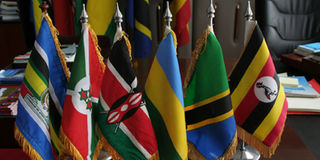End mistrust to attain EAC integration goals

Flags of EAC member States.
What you need to know:
- In fact all East Africans must reflect and ask themselves whether their actions and words have been advancing the cause of integration or have been the stumbling block to the EAC projects.
- We say this because despite having been one of the most advanced regional economic blocs in Africa in terms of trade and economic integration the EAC still faces a myriad of challenges that, at times make people wonder whether the integration process is worth it.
The Summit of the Heads of State of the East African Community (EAC) that took place yesterday in Dar es Salaam should serve as an opportunity for regional leaders and all other stakeholders to reflect on the noble mission of cohesive integration.
In fact all East Africans must reflect and ask themselves whether their actions and words have been advancing the cause of integration or have been the stumbling block to the EAC projects.
We say this because despite having been one of the most advanced regional economic blocs in Africa in terms of trade and economic integration the EAC still faces a myriad of challenges that, at times make people wonder whether the integration process is worth it.
Most of the challenges have their roots deep into the issue of how to balance between national interests and common interests, especially on issues that are crucial to the advancement of trade and economic integration of the region.
This delicate balance act has, at times, turned into mistrust between member states. One hand we have some few member states who are ready to compromise national interests in most of the issues and on the other hand we have the majority of the member states who seem hesitant.
We saw this trend during negotiations for the Customs Union and the Common Market. The two protocols were signed successfully and came into effect in 2005 and 2010 respectively but not without more than usual back and forth and much hesitation among member states. At one point it seemed as if the Common Market was not going to become a reality when the contentious issue of land became the subject of so much division and bad feelings among members states during the negotiations. It was only when the decision to let land laws continue being under the jurisdiction of national laws of respective countries that CM negotiations did advance.
Some EAC states accused of dragging their feet
It is also safe to say that the mistrust has been heightened by politicians and the media when they point fingers to some member states and accuse them of dragging their feet in the integration process even at those times when the member states have valid concerns. If there are problems that are stalling the integration process it is because all, and not only some members, are responsible.
For example during the negotiations for the Customs Union and Common Market which were conducted separately some member states, including Tanzania raised very valid issues about the need for the two protocols to consider the differences in the levels of economic advancement of member states. The argument was that allowing free movement of labour, goods, services and capital could impact negatively the economies of those member states with smaller economies and benefit economies of those members who have more advanced economies.
The high level of mistrust led to misunderstandings and to the view that these valid concerns were mere excuses by those member states that allegedly did not want to open up their economies.
Suprisingly those member states that were regarded as hesitant became champions of the implementation of the CU and CM, according to some reports.
It is for this reason that we hope all key stakeholders and especially politicians, lawmakers and Heads of State whose influence is key to the integration process will assess their commitment to the process.




